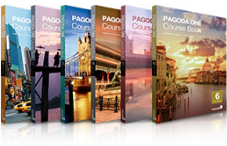
Package Component
A complete package per level is encased in a beautiful box with 1 Coursebook and 1 DVD. Each Coursebook is made up of 30 lessons, each contacting 3 minute situational videos that accurately matches the lesson objective.
Definition of levels
Level 1
Building the Base
Generate articulate Level 1 covers the highest-frequency language functions in a progressive manner. The course is good for complete beginners, but also for students who have learned the basics of English in school but lack the confidence to use them accurately in a real conversation with native speakers. Students who take the time to master Level 1 material will have a much easier time pursuing advanced language studies.
Level 2
Expanding the Base
Level 2 expands upon the base built in level 1. The student will learn to distinguish between different ways of describing events in the past, tell stories, and explain more abstract ideas. This material is also very appropriate for students who have studied English at higher levels but are seeking a refresher course to get solid on the core concepts of the language.
Level 3
Activating Core Knowledge
At level 3, the student is ready to practice the language by discussing a variety of topics. More advanced language such as idioms and collocations will gradually be introduced, as well as more detailed grammar patterns. This is a great starting point for students who feel very comfortable expressing basic concepts and now want to build fluency and confidence.
Level 4
Exploring New Contexts
Level 4 exposes the student to a greater variety of contexts. Level 4 introduces new venues such as interviews, presentations, and group discussions. It a good starting point for a student who can converse comfortably in English but still misses social cues or expresses some things awkwardly when immersed in an all-English milieu
Level 5
Deepening Discussion
At level 5, the student has the opportunity to build toward higher levels of proficiency with more advanced topics such as science and health, education, and travel. This is a good place for a student who speaks English well and wants to build more skill discussing current events and controversial issues.
Level 6
Bringing it All Together
By Level 6, the student is having many of the same conversations that native speaker have every day. As always, the lessons continue to review the basics, but the skills are applied in more in-depth scenarios, at full native speed. This is a good starting point for students who have extensive background studying English, perhaps also including a period living overseas.
Lesson Structure
Each lesson is structured around a short video containing key concepts used by native speakers in
Warm - up
Each lesson begins with a few warm-up questions about a situation related to the topics encountered in the lesson. The student uses their existing knowledge to begin thinking about the material and discussing it.Building Content
Content is built with a brief reading task, introducing relevant vocabulary and providing additional background information to consider and discuss.Preview
In the preview section, the student reviews note-taking and comprehension exercises to ensure understanding of the lesson’s video dialogue. As the section’s name would suggest, we recommend completing these exercises before class and then reviewing them during the session. This will allow for maximum discussion time in the class.Discussion
Live interaction and feedback are the heart of any productive session. Using the material covered as a starting point, the student should make every effort to maximize his/her speaking time in this section, receiving as much detailed, individualized feedback as possible. In a classroom setting, this crucial element comes from interaction with classmates and the instructor, with feedback from the instructor. In a self-study environment, it can come from a practice partner or study group. In the latter environment, self-monitoring and peer feedback become very important elements for improvement. Although it may be harder in a self-study environment, it is not impossible. With effort there is always some way to get this live practice.Building Skills
This section is similar to the Building Strategy section, but it is function-specific. In other words, this section gives tips about one function (pronunciation, grammar, or vocabulary/expressions) that occurs in the dialogue, with additional examples and practice. This is followed by a chance to practice authentic pronunciation with selected extracts from the video.Wrap up
At the end of the session, take a moment to review key vocabulary and concepts from the lesson and preview the topic of the next session. Homework is always optional, but every minute spent reviewing and preparing outside of class will make your class time a little bit more enjoyable and productive.